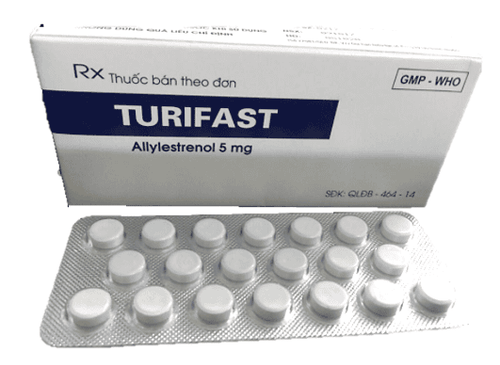This is an automatically translated article.
Oxylpan is a great solution to help pregnant women ease labor, induce labor or to reduce bleeding where the placenta is attached. Oxylpan is a prescription drug, so to ensure effective use, users need to follow their doctor's instructions, and refer to the following article for more information about the uses of Oxylpan.
1. What are the uses of Oxylpan?
1.1. What is Oxylpan? Oxylpan is a drug belonging to the group of drugs that have the effect of promoting labor, stopping postpartum bleeding and preventing premature birth. Oxylpan medicine has the main ingredient of Oxytocin 5 IU/ml
The drug is prepared in the form of an injection solution, and is packaged in boxes of 10 ampoules, 20 ampoules, 100 ampoules x 1ml tubes.
1.2. What does Oxylpan do? Indications for use of Oxylpan
Oxylpan induces labor in pregnant women who are about to give birth or are about to give birth. Induction of labor when labor is prolonged. Helps prevent and treat postpartum bleeding. Contraindications for the use of Oxylpan
Contraindicated with intense uterine contractions such as: fetal distress before delivery, mechanical obstruction of the delivery tract, cases where a natural delivery is not possible (eg: abnormal position, size mismatch between fetal head and pelvis, placenta previa, placental abruption, vagal previa...) Avoid prolonged use in patients with oxytocin-resistant uterine atony, eclampsia , pregnancy toxicity or cardiovascular disease. Patients with known hypersensitivity to oxytocin.
2. Usage of Oxylpan
2.1. How to take Oxylpan Oxylpan is administered by injection IM injection; When immediate effect is needed, slow IV injection can be given. The dose for IM or IV injection is: 1 to 3IU. In caesarean section procedures 5IU is injected into the uterine muscle. If in gynecology 5 to 10IU, SC or IM injection. 2.2. Dosage of the drug Oxylpan In case of induction of labor:
Perform intravenous infusion. Before intravenous infusion, care should be taken to dilute the drug with 0.9% sodium chloride solution or Ringer lactate solution or 5% dextrose solution to an appropriate concentration and inject. In case of cesarean section:
Slow intravenous infusion of 5 units right after the pregnancy is removed. Prevention of postpartum bleeding:
Immediately after placental abruption, slow intravenous injection of 5 units. If intravenous infusion has been given to induce labor or to induce labor previously, the infusion rate should be increased during phase 3 or within a few hours.) Treatment of postpartum bleeding:
5 units slow intravenous injection (This dose can be repeated). In severe cases, intravenous infusion of 40 units per 500 ml and fluid at an appropriate rate can be used to control uterine atony. Avoid rapid intravenous injection because it may cause a temporary drop in blood pressure. Therefore, it is necessary to perform the injection slowly. Miscarriage:
Perform slow intravenous injection of 5 units. Thereafter, intravenous infusion of 0.02 to 0.04 units per minute or faster if necessary. To avoid toxicity and hyponatremia, the total dose over 12 hours should be 30 units or less.
3. Note when using Oxylpan
Only highly specialized staff in hospitals with available facilities for intensive care, and surgery can receive oxytocin.
While taking oxytocin, it is necessary to continuously monitor uterine contractions, fetal and maternal heart rate, maternal blood pressure and also intrauterine pressure, to avoid complications.
If intense uterine contractions occur, oxytocin should be discontinued immediately.
Uterine contractions due to oxytocin usually subside soon after stopping the drug.
Because oxytocin can cause some antidiuretic effects, it is recommended to limit fluid intake and avoid the use of low-sodium infusion solutions.
Avoid taking high doses of oxytocin for too long, and monitor fluid intake and excretion during dosing.
Pregnancy:
Oxytocin should not be used during the first 3 to 6 months of pregnancy, except in cases of spontaneous abortion or induced abortion. Oxytocin does not cause fetal malformations when used as indicated.
4. Oxylpan side effects
Using Oxylpan may experience the following adverse reactions such as: Arrhythmia, anaphylaxis, arrhythmia, postpartum hemorrhage or nausea.
In patients with asthma, bronchospasm may develop. Overdosage or hypersensitivity to the drug may result in uterine hypertonicity, tetanus-like contractions, contractions, or uterine rupture.
The following adverse reactions may occur in children and fetuses: permanent brain or central nervous system damage, bradycardia or arrhythmias. Apgar score will be low 5 minutes after the patient takes the medicine.
5. Oxylpan drug interactions
5.1 Oxylpan Drug Interactions with Other Drugs Drug interactions can change the ability and action of the drug or increase the effects of side effects. Tell your doctor or pharmacist of all prescription and over-the-counter medicines, vitamins, minerals and herbal products, and medicines prescribed by other doctors. For the safest medication, always consult your doctor.
5.2 Oxylpan Drug Interactions with Food and Drink Certain drugs should not be taken with meals or at the same time as certain foods, because interactions can occur. Alcohol, beer, and tobacco, too, can also interact with some medications. Always consult medical teams about taking medications with food, alcohol, beer and tobacco.
6. How to store Oxylpan
If the drug is not stored well, the concentration, content and active ingredients of the drug will be affected or when the expiry date of the drug is expired, it will be dangerous when used. It is necessary to carefully read the information on the storage of the drug and the expiry date of the medicine that has been written on the product packaging and the drug instruction sheet. Usually medicines are stored at room temperature (between 15 and 30°C) away from moisture and light. The above are the uses of Oxylpan, users should refer to to better understand the mechanism of action and effects of the drug, from which to make appropriate choices.













